2009 Seat Altea XL bonnet
[x] Cancel search: bonnetPage 225 of 297
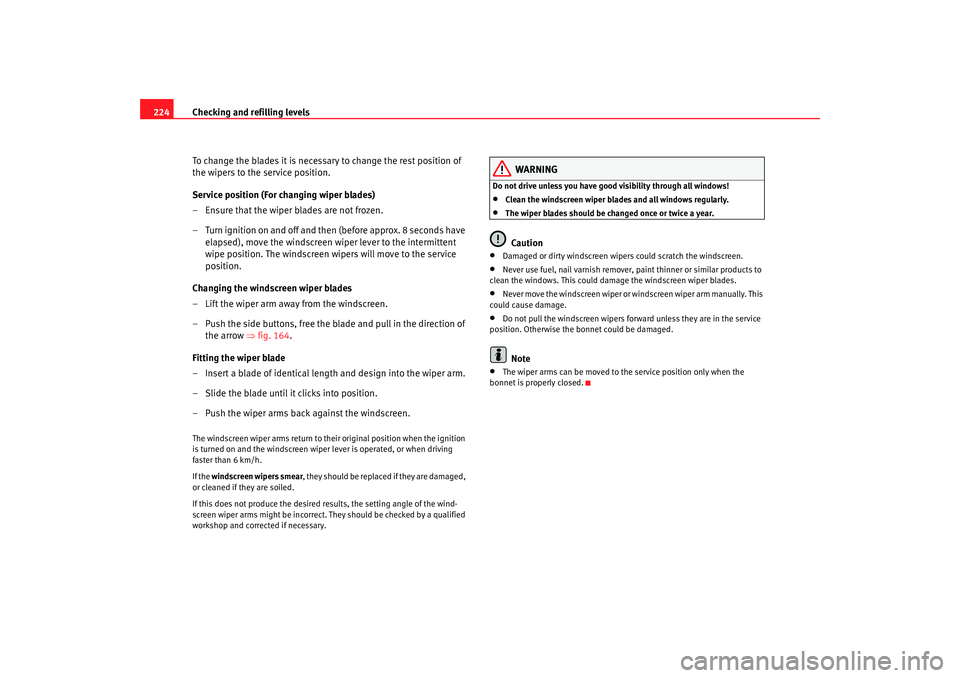
Checking and refilling levels
224
To change the blades it is necessary to change the rest position of
the wipers to the service position.
Service position (For changing wiper blades)
– Ensure that the wiper blades are not frozen.
– Turn ignition on and off and then (before approx. 8 seconds have elapsed), move the windscreen wiper lever to the intermittent
wipe position. The windscreen wi pers will move to the service
position.
Changing the windscreen wiper blades
– Lift the wiper arm away from the windscreen.
– Push the side buttons, free the blade and pull in the direction of the arrow ⇒fig. 164.
Fitting the wiper blade
– Insert a blade of identical length and design into the wiper arm.
– Slide the blade until it clicks into position.
– Push the wiper arms back against the windscreen.The windscreen wiper arms return to their original position when the ignition
is turned on and the windscreen wiper lever is operated, or when driving
faster than 6 km/h.
If the windscreen wipers smear , they should be replaced if they are damaged,
or cleaned if they are soiled.
If this does not produce the desired results, the setting angle of the wind-
screen wiper arms might be incorrect. They should be checked by a qualified
workshop and corrected if necessary.
WARNING
Do not drive unless you have good visibility through all windows!•
Clean the windscreen wiper blades and all windows regularly.
•
The wiper blades should be changed once or twice a year.Caution
•
Damaged or dirty windscreen wipers could scratch the windscreen.
•
Never use fuel, nail varnish remover, paint thinner or similar products to
clean the windows. This could damage the windscreen wiper blades.
•
Never move the windscreen wiper or windscreen wiper arm manually. This
could cause damage.
•
Do not pull the windscreen wipers forward unless they are in the service
position. Otherwise the bonnet could be damaged.Note
•
The wiper arms can be moved to the service position only when the
bonnet is properly closed.
AlteaXL_EN.book Seite 224 M ontag, 2. Februar 2009 12:26 12
Page 227 of 297

Checking and refilling levels
226Brake fluidChecking the brake fluid level
The brake fluid is checked at the intervals given in the service
schedule.– Read off the fluid level at the transparent brake fluid reservoir. It
should always be between the “MIN” and “MAX” marks.The position of the brake fluid reservoir is shown in the corresponding engine
compartment diagram ⇒ page 273. The brake fluid reservoir has a black and
yellow cap.
The brake fluid level drops slightly when the vehicle is being used as the
brake pads are automatically adjusted as they wear. However, if the level goes down noticeab
ly in a short time, or drops below the
“MIN” mark, there may be a leak in the brake system. A display on the instru-
ment panel will warn you if the brake fluid level is too low ⇒page 73.
WARNING
Before opening the bonnet to check the brake fluid level, read and observe
the warnings ⇒page 213.Changing the brake fluid
The Maintenance Program indicates the brake fluid change
intervals.We recommend that you have the brake fluid changed by an Authorised
Service Centre.
Before opening the bonnet, please read and follow the warnings ⇒ in
“Safety instructions on working in the engine compartment” on page 213 in
“Working in the engine compartment”.
Brake fluid absorbs moisture. In the cour se of time, it will absorb water from
the ambient air. If the water content in the brake fluid is too high, the brake
system could corrode. This also consider ably reduces the boiling point of the
brake fluid. Heavy use of the brakes may then cause a vapour lock which
could impair the braking effect.
It is important that you use only brake fluid compliant with the US standard
FMVSS 116 DOT 4. We recommend the use of Genuine SEAT brake fluid.
WARNING
Brake fluid is poisonous. Old brake fluid impairs the braking effect.
Fig. 167 In the engine
compartment: Brake fluid
reservoir cover
AlteaXL_EN.book Seite 226 Montag, 2. Februar 2009 12:26 12
Page 228 of 297
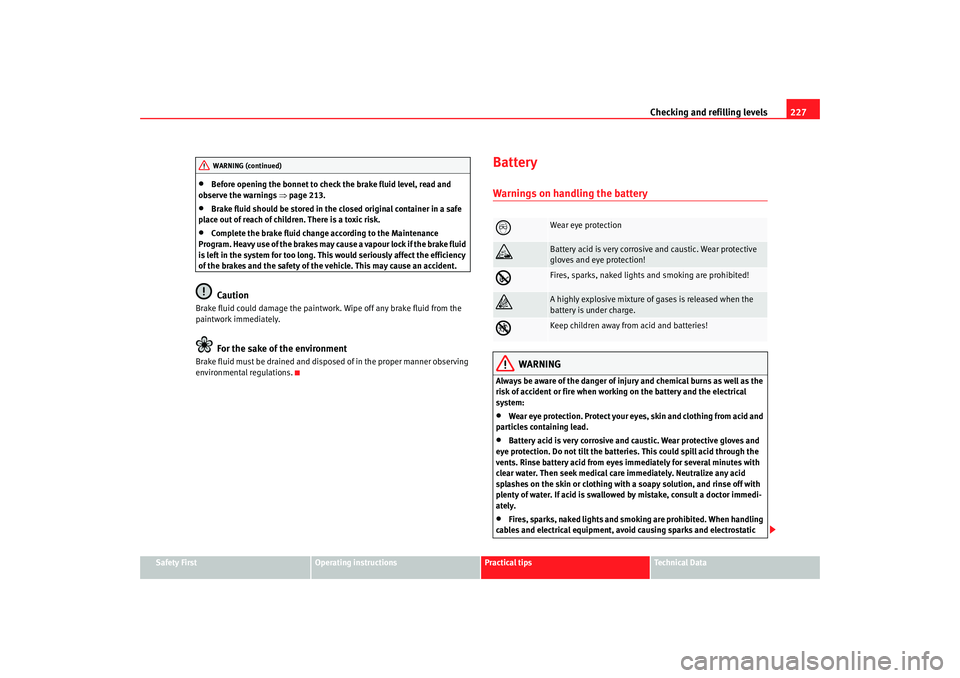
Checking and refilling levels227
Safety First
Operating instructions
Practical tips
Te c h n i c a l D a t a
•
Before opening the bonnet to check the brake fluid level, read and
observe the warnings ⇒page 213.
•
Brake fluid should be stored in the closed original container in a safe
place out of reach of children. There is a toxic risk.
•
Complete the brake fluid change according to the Maintenance
Program. Heavy use of the brakes may cause a vapour lock if the brake fluid
is left in the system for too long. This would seriously affect the efficiency
of the brakes and the safety of the vehicle. This may cause an accident.Caution
Brake fluid could damage the paintwork. Wipe off any brake fluid from the
paintwork immediately.
For the sake of the environment
Brake fluid must be drained and disposed of in the proper manner observing
environmental regulations.
BatteryWarnings on handling the battery
WARNING
Always be aware of the danger of injury and chemical burns as well as the
risk of accident or fire when working on the battery and the electrical
system:•
Wear eye protection. Protect your eyes , skin and clothing from acid and
particles containing lead.
•
Battery acid is very corrosive and caustic. Wear protective gloves and
eye protection. Do not tilt the batter ies. This could spill acid through the
vents. Rinse battery acid from eyes immediately for several minutes with
clear water. Then seek medical care immediately. Neutralize any acid
splashes on the skin or clothing with a soapy solution, and rinse off with
plenty of water. If acid is swallowed by mistake, consult a doctor immedi-
ately.
•
Fires, sparks, naked lights and smoki ng are prohibited. When handling
cables and electrical equipment, avoid causing sparks and electrostatic
WARNING (continued)
Wear eye protection
Battery acid is very corrosive and caustic. Wear protective
gloves and eye protection!
Fires, sparks, naked lights and smoking are prohibited!
A highly explosive mixture of gases is released when the
battery is under charge.
Keep children away from acid and batteries!
AlteaXL_EN.book Seite 227 M ontag, 2. Februar 2009 12:26 12
Page 229 of 297

Checking and refilling levels
228charge. Never short the battery terminals. High-energy sparks can cause
injury.•
A highly explosive mixture of gases is released when the battery is
under charge. The batteries should be charged in a well-ventilated room
only.
•
Keep children away from acid and batteries.
•
Before working on the electrical system, you must switch off the
engine, the ignition and all consumers. The negative cable on the battery
must be disconnected. When a light bulb is changed, you need only switch
off the light.
•
Deactivate the anti-theft alarm by unlocking the vehicle before you
disconnect the battery! The alarm will otherwise be triggered.
•
When disconnecting the battery from the vehicle electrical system,
disconnect first the negative cable and then the positive cable.
•
Switch off all electrical consumers before reconnecting the battery.
Reconnect first the positive cable and then the negative cable. Never
reverse the polarity of the connections. This could cause an electrical fire.
•
Never charge a frozen battery, or one which has thawed. This could
result in explosions and chemical burns. Always replace a battery which
has frozen. A flat battery can freeze at temperatures around 0°
•
Ensure that the vent hose is always connected to the battery.
•
Never use a defective battery. This may be fatally explosive. Replace a
damaged battery immediately.Caution
•
Never disconnect the battery if the ignition is switched on or if the engine
is running. This could damage the electrical system or electronic compo-
nents.
•
Do not expose the battery to direct sunlight over a long period of time, as
the intense ultraviolet radiation can damage the battery housing.
•
If the vehicle is left standing in cold conditions for a long period, protect
the battery from frost. If it “freezes” it will be damaged.
Checking the electrolyte level
The electrolyte level should be checked regularly in high-
mileage vehicles, in hot countries and in older batteries.– Open the bonnet and open the battery cover at the front ⇒ in
“Safety instructions on working in the engine compartment” on
page 213 ⇒ in “Warnings on handling the battery” on
page 227.
– Check the colour display in the "magic eye" on the top of the battery.
– If there are air bubbles in the window, tap the window gently until they disperse.The position of the battery is show n in the corresponding engine compart-
ment diagram ⇒page 273.
The round window (“magic eye”) on the top of the battery changes colour,
depending on the charge level and electrolyte level of the battery.
If the colour in the window is colourless or bright yellow, the electrolyte level
of the battery is too low. Have the battery checked by a qualified workshop.
The colours green and black are used by the workshops for diagnostic
purposes.
WARNING (continued)
AlteaXL_EN.book Seite 228 M ontag, 2. Februar 2009 12:26 12
Page 256 of 297
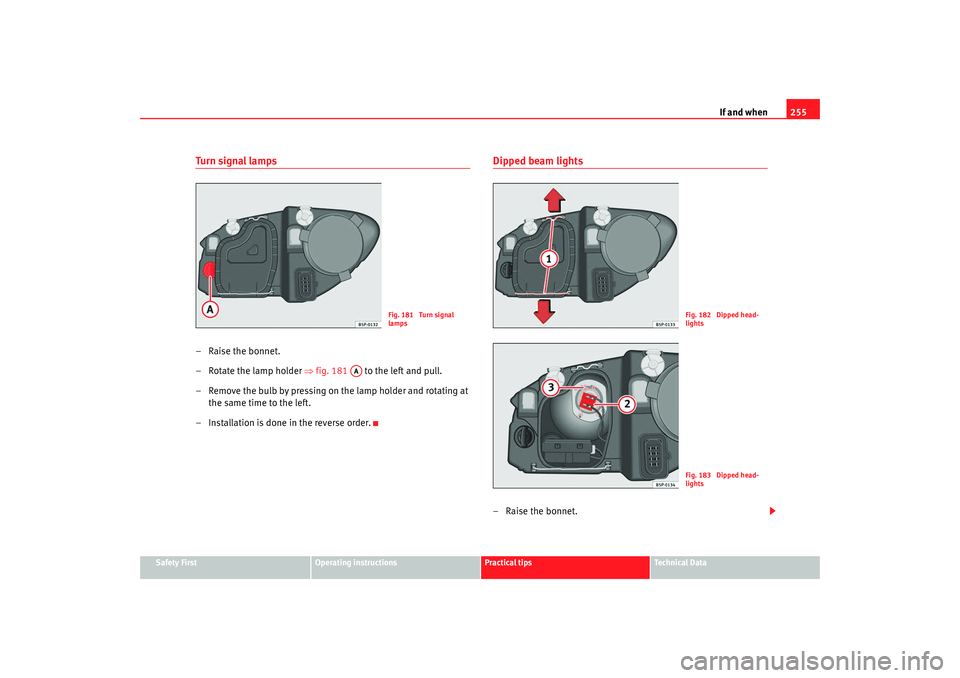
If and when255
Safety First
Operating instructions
Practical tips
Te c h n i c a l D a t a
Turn signal lamps–Raise the bonnet.
– Rotate the lamp holder ⇒fig. 181 to the left and pull.
– Remove the bulb by pressing on the lamp holder and rotating at the same time to the left.
– Installation is done in the reverse order.
Dipped beam lights– Raise the bonnet.
Fig. 181 Turn signal
lamps
AA
Fig. 182 Dipped head-
lightsFig. 183 Dipped head-
lights
AlteaXL_EN.book Seite 255 M ontag, 2. Februar 2009 12:26 12
Page 257 of 297
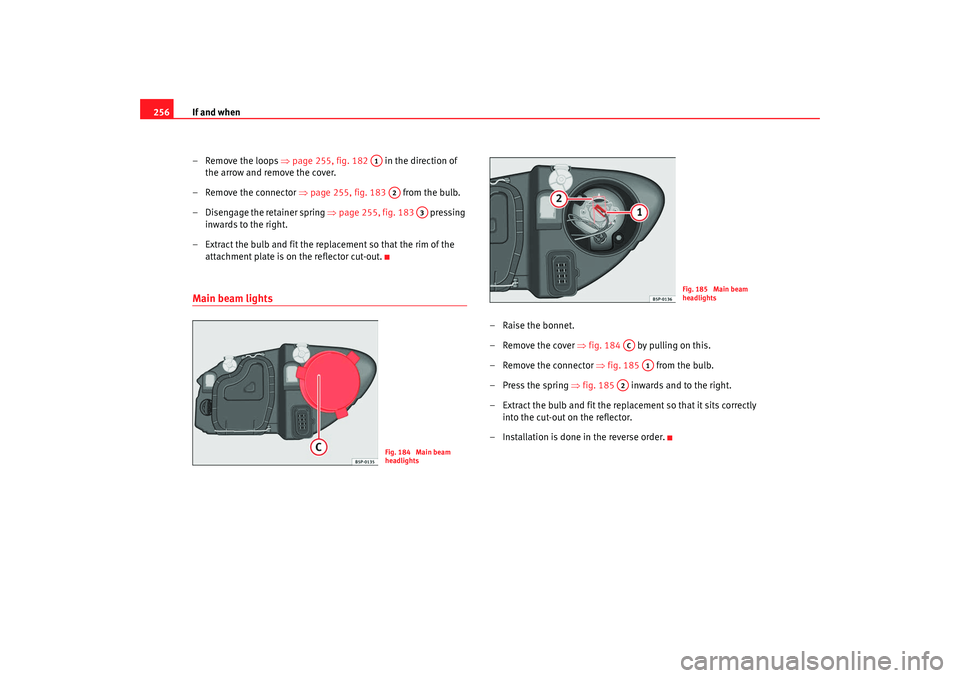
If and when
256
– Remove the loops ⇒page 255, fig. 182 in the direction of
the arrow and remove the cover.
– Remove the connector ⇒page 255, fig. 183 from the bulb.
– Disengage the retainer spring ⇒ page 255, fig. 183 pressing
inwards to the right.
– Extract the bulb and fit the replacement so that the rim of the attachment plate is on the reflector cut-out.Main beam lights
–Raise the bonnet.
– Remove the cover ⇒fig. 184 by pulling on this.
– Remove the connector ⇒fig. 185 from the bulb.
– Press the spring ⇒fig. 185 inwards and to the right.
– Extract the bulb and fit the replacement so that it sits correctly into the cut-out on the reflector.
– Installation is done in the reverse order.
A1
A2
A3
Fig. 184 Main beam
headlights
Fig. 185 Main beam
headlights
AC
A1
A2
AlteaXL_EN.book Seite 256 M ontag, 2. Februar 2009 12:26 12
Page 258 of 297
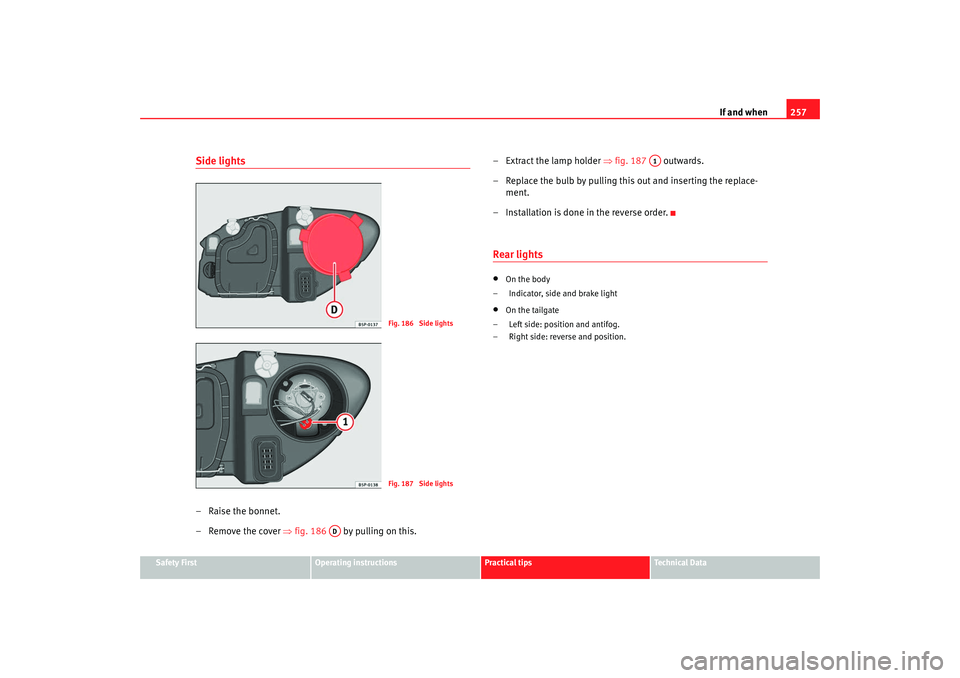
If and when257
Safety First
Operating instructions
Practical tips
Te c h n i c a l D a t a
Side lights–Raise the bonnet.
– Remove the cover ⇒fig. 186 by pulling on this. – Extract the lamp holder
⇒fig. 187 outwards.
– Replace the bulb by pulling this out and inserting the replace- ment.
– Installation is done in the reverse order.
Rear lights•
On the body
– Indicator, side and brake light
•
On the tailgate
– Left side: position and antifog.
– Right side: reverse and position.
Fig. 186 Side lightsFig. 187 Side lights
AD
A1
AlteaXL_EN.book Seite 257 M ontag, 2. Februar 2009 12:26 12
Page 288 of 297

Index287
Index
AABS . . . . . . . . . . . . . . . . . . . . . . . . . . . . . . . . . . . 184
Warning lamp . . . . . . . . . . . . . . . . . . . . . . . . . 77
Accessories . . . . . . . . . . . . . . . . . . . . . . . . . . . . 208
Acoustic signal . . . . . . . . . . . . . . . . . . . . . . . . . . 19
Acoustic warning . . . . . . . . . . . . . . . . . . . . . . . . 165
Adjusting the seat belt height . . . . . . . . . . . . . . 26
AFS (curve lights) . . . . . . . . . . . . . . . . . . . . . . . . 113
Air conditioner* 2C-Climatronic* . . . . . . . . . . . . . . . . . . . . . . 157
Air conditioning system General notes . . . . . . . . . . . . . . . . . . . . . . . . 161
Air conditioning* . . . . . . . . . . . . . . . . . . . . . . . . 153
Air recirculation mode 2C-Climatronic . . . . . . . . . . . . . . . . . . . . . . . 161
Manual air conditioning . . . . . . . . . . . . . . . 155
Airbag covers . . . . . . . . . . . . . . . . . . . . . . . . . . . . 35
Airbag system . . . . . . . . . . . . . . . . . . . . . . . . . . . 29 Curtain airbags . . . . . . . . . . . . . . . . . . . . . . . 40
Front airbags . . . . . . . . . . . . . . . . . . . . . . . . . 33
Side airbags . . . . . . . . . . . . . . . . . . . . . . . . . . 36
Warning lamp . . . . . . . . . . . . . . . . . . . . . . . . . 30
Alarm system Switching off . . . . . . . . . . . . . . . . . . . . . . . . 100
Alternator Warning lamp . . . . . . . . . . . . . . . . . . . . . . . . . 78
Ambient temperature display . . . . . . . . . . . . 62, 69 Anti-freeze . . . . . . . . . . . . . . . . . . . . . . . . . . . . . 220
Anti-lock brake system . . . . . . . . . . . . . . . . . . . 184
Warning lamp . . . . . . . . . . . . . . . . . . . . . . . . . 77
Anti-puncture tyres . . . . . . . . . . . . . . . . . . . . . . 233
Anti-theft alarm system . . . . . . . . . . . . . . . . . . . 100 Switching off . . . . . . . . . . . . . . . . . . . . . . . . 100
Anti-theft wheel bolts . . . . . . . . . . . . . . . . . . . . 242
Aquaplaning . . . . . . . . . . . . . . . . . . . . . . . . . . . 233
Ashtray* . . . . . . . . . . . . . . . . . . . . . . . . . . . . . . . 144
Automatic anti-dazzle interior mirror* Activating the anti-dazzle function . . . . . . 125
Deactivating anti-dazzle function . . . . . . . . 125
Automatic car wash tunnel . . . . . . . . . . . . . . . . 200
Automatic gearbox / DS G automatic gearbox . 170
Automatic lighting . . . . . . . . . . . . . . . . . . . . . . . 110
Automatic mode 2C-Climatronic . . . . . . . . . . . . . . . . . . . . . . . 159
Automatic wiper/wash function for the rear window 124
Auxiliary audio connection: AUX-IN . . . . . . . . . 146
BBall coupling . . . . . . . . . . . . . . . . . . . . . . . . . . . 196
BAS . . . . . . . . . . . . . . . . . . . . . . . . . . . . . . . . . . . 183 Battery
Changing . . . . . . . . . . . . . . . . . . . . . . . . . . . 229
Charging . . . . . . . . . . . . . . . . . . . . . . . . . . . . 229
Winter conditions . . . . . . . . . . . . . . . . . . . . 227
Belt tension device Disposal . . . . . . . . . . . . . . . . . . . . . . . . . . . . . 27
Warning lamp . . . . . . . . . . . . . . . . . . . . . . . . 30
Belt tension devices . . . . . . . . . . . . . . . . . . . . . . 27
Biodiesel . . . . . . . . . . . . . . . . . . . . . . . . . . . . . . 212
Biodiesel fuel . . . . . . . . . . . . . . . . . . . . . . . . . . . 212
Bonnet . . . . . . . . . . . . . . . . . . . . . . . . . . . . . . . . 215
Brake assist system . . . . . . . . . . . . . . . . . . . . . 183
Brake fluid . . . . . . . . . . . . . . . . . . . . . . . . . . . . . 226 Brake fluid . . . . . . . . . . . . . . . . . . . . . . . . . . . 63
Changing . . . . . . . . . . . . . . . . . . . . . . . . . . . 226
Brake pads . . . . . . . . . . . . . . . . . . . . . . . . . . . . . 190
Brake servo . . . . . . . . . . . . . . . . . . . . . . . 183, 190
Brake system . . . . . . . . . . . . . . . . . . . . . . . . . . . 226 Brake servo . . . . . . . . . . . . . . . . . . . . . . . . . 188
Brakes . . . . . . . . . . . . . . . . . . . . . . . . . . . . . 188
Warning lamp . . . . . . . . . . . . . . . . . . . . . . . . 79
Brakes . . . . . . . . . . . . . . . . . . . . . . . . . . . . . . . . 190
Braking distance . . . . . . . . . . . . . . . . . . . . . . . . 190
Bulb changes general notes . . . . . . . . . . . . . . . . . . . . . . . . 253
Bulb defect warning lamp . . . . . . . . . . . . . . . . . . . . . . . . . 79
Buzzer . . . . . . . . . . . . . . . . . . . . . . . . . . . . 116, 165
AlteaXL_EN.book Seite 287 M ontag, 2. Februar 2009 12:26 12